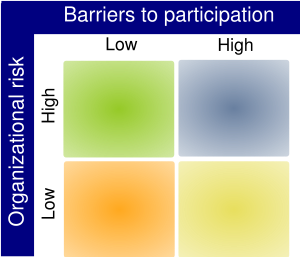Internationalising online programs/Introduction
Contents
Overview Goals
Internationalizing the university is an enormous topic that is complex, value laden, and contextual. At the most basic level the idea of this Workshop is to illustrate that international involvement can take varied forms and that different types of activities have different risk profiles and require different types of organizational readiness (capacity). Some activities can be very low barrier and low risk, but be very satisfying, while others require significant investment, pre-existing institutional capacity, and assume a lot of risk. In the US context, international activity frequently boils down to identifying new markets and steams of revenue. We want to help generate an enabling dialog that reinforces that international activities are not necessarily all about "going into China "and getting a bunch of students.
- Develop a broad understanding of international activities.
- Identify contextually appropriate ways of engaging in international activities.
- Better identify benefits accrued through various activities.
- Reflect on organizational readiness (capacity) for specific activities.
Introduction
Background
There is continuous discussion about the opportunities, challenges, and benefits of “internationalizing” the university. In the US, organizations such as National Association of State Universities and Land-Grant Colleges (NASULGC) and American Distance Education Consortium (ADEC) formally address issues of international education and the role of the academy. Internationally, organizations such as COL, ICDE, OECD/CERI, and UNESCO work in different aspects of educational on a global level. We, in this workshop, are interested in starting a dialog about how universities with different levels of current international involvement and capacity can effectively work toward internationalizing their own university or college in ways that are appropriate and meet organizational goals.
- Use a framework that helps balance risk, reward, and organizational readiness.
- Illustrate the use of an Activity Matrix supporting the framework as a way to discuss and explore a variety of international activities.
- Prepare concept projects to test the usefulness of the framework and Activity Matrix
Activity Matrix
To facilitate this process, we have drafted an “Activity Matrix” with the intent of providing a framework that identifies varied types of international involvement and aligns them with organizational commitments and capacity. Organizational commitment are reflects in mission, value, and goal statements, while capacity is reflected in experience, resourcing , and formal structures in the organization designed and staffed to support international activities.
In the matrix we provide examples of activities, and some considerations for involvement to help planning and successful implementation. In the examples, we express the framework by providing:
- A Description of the Activity: A short description of the activity or project that was undertaken including the goals of the activity from the perspective of the participants.
- The Benefits of the Activity: A description of the benefits and intended benefits that the organization accrued through the activity or project.
- Success Factors for the Activity: A description or listing of the elements or factors necessary or present to help ensure that the benefits of the activity or project are realized.
- Organizational Readiness Factors: A short description or list of capacity that the organization possess that helps to ensure activity or project success, what has to be developed, and how.
- Exit and Sustainability Plans: A description of how the organization will mange project success, failure, sustainability, and closure.
The Activity Matrix is a way to think about approaching international projects that are appropriate relative to organizational mission, readiness, and goals. Within the context of the Workshop, it is used as a method to stimulate discussion and share experiences, and international efforts, identify new ideas, assess institutional readiness, and start to think about the many ways that everybody in the organization can extend to, participate in, and befit from enhancing international activities.
Risk, Reward, and Organizational Readiness Model
In this workshop we will use a simple framework for classifying the examples of internationalisation. This is based on using a matrix which contrasts the barriers of participation with organisational risk. Barriers to participation are essentially a measure of organisational readiness whereas risk is a measure of the potential negative impact to our operations expressed as the possibility of failure. Organisationally speaking, an international activity can be classified as:- Low risk corresponding with low barriers to participation (Orange quadrant);
- High risk and low barriers to participation (Green quadrant);
- Low risk but high barriers to participation (Yellow quadrant); and
- High risk corresponding with high barriers to participation (Blue quadrant).
Additional Considerations
There are many options for involvement in international educational activities. Some activities are more demanding than others, some require more resources, capacity, and carry different levels of risk. There are a number of factors to consider while making choices for international involvement. Although we this Workshop will focus on online learning related approaches and activities, it could be applied across a number of domains.
Some of the areas to consider are:
- Institutional Mission
- Capacity & Experience
- Approaches & Methods
Insitutional Mission
Why would you want to do this? What are you trying to achieve?
- How does the effort relate to your personal, departmental, and institutional goals, values, & mission?
- What are the goals of online learning and international involvement?
- Is online learning among the most effective ways of attaining those goals?
Capacity & Experience
What do I know about online learning and international education?
- What level of investment and risk is the institution willing to incur?
- What is the institution's current level of capacity for online learning and international programming?
- What are the local conditions for the learners and institutions that will engage in the program?
Approaches & Methods
What might I do to ensure sustainability, affordability & relevance?
- Partnerships, business models, and local government support
- Delivery methods (online, blended, hybrid, etc.)
- Localization strategies
- Licensing and use of open educational resources (OER), open source software (OSS), OA literature, etc.
